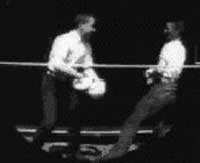 The demonstration film Men Boxing (1891) was not intended for public viewing except to investors or a privileged few. The demonstration film Men Boxing (1891) was not intended for public viewing except to investors or a privileged few.
And yet already in 1891 William K. L. Dickson & the guys at the Edison company seemed to have a sense that boxing was going to be a commercial grabber for the nascent filmmaking industry.
Men Boxing is fake boxers giggling & pretending to box, viewed through a round aperture. The first serious fight film was Leonard-Cushing Fight (1894), also by Dickson, with assistance from his usual photographer William Heise.
That one, however, wasn't an authentic match, but consisted of two Edison employees in their office clothes wearing huge white boxing gloves standing in boxing poses without actually trying to hit each other.
If we wanted to push boxing in motion pictures back further, there's Eadweard Muybridge's "Boxing: Open Hand" sequential photographs designed to be viewed through a pinhole on a rigid disc, spinning in such a manner as to convey motion, a device predating motion picture film. Part of Muybridge's boxing sequence is shown above.
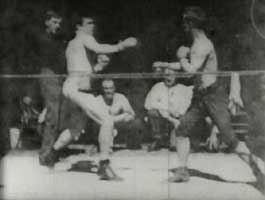 But even with these provisos, the first boxing match on film would still be the Leonard-Cushing Fight. Footage initially consisted of six rounds, each round on a different piece of film, each round sold separately to be viewed in a kinetoscope. But even with these provisos, the first boxing match on film would still be the Leonard-Cushing Fight. Footage initially consisted of six rounds, each round on a different piece of film, each round sold separately to be viewed in a kinetoscope.
Only a fragment a bit over half a minute survives, from the paper-negative submitted by the Edison Company to the Library of Congress for copyright purposes.
The filmmakers well knew these multi-part films were kind of phony & that it didn't matter which round one saw or the order they were seen in, except the last which would have the pre-arranged conclusion. So Edison's company only submitted one section of film for copyright, saving the labor of making paper negatives of all the other frames of the film.
There is no boxing ring per se set up, the men are just boxing in front of the camera, but to give it some semblance of realism, a row of spectators sits at the rear of the stage. These are strong fellows & the fight might not be entirely authentic, but those bare-fisted punches are real enough, & the referee's body language indicates skittishness about stepping in between.
Dickson & his crew at the Black Maria studio were surprised how popular this film was, & the demand for boxing films would become a major part of their production slate.
Such commercial considerations meant that any artistic desire to make plotted playlets or trick-films or anything imaginative had to become a side-line, & the really imaginative leaps would appear first in Paris from Georges Melies' Star Films studio, Melies having been independent rather than attached to a big company like Edison Manufacturing.
On the other hand, the popularity of such films did much to advance what would become a history of newsreels.
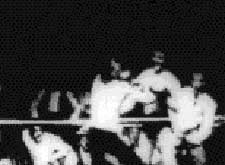 Boxers James J. "Gentleman Jim" Corbett & Peter Courtney were captured in six one-minute rounds for Corbett & Courtney Before the Kinetograph (1894). It was the second boxing match ever in a motion picture, William L. K. Dickson having directed the first, The Leonard-Cushing Fight.
Boxers James J. "Gentleman Jim" Corbett & Peter Courtney were captured in six one-minute rounds for Corbett & Courtney Before the Kinetograph (1894). It was the second boxing match ever in a motion picture, William L. K. Dickson having directed the first, The Leonard-Cushing Fight.
Corbett was the heavyweight champion who defeated John L. Sullivan, & Courtney was the underdog. This was the most profitable film of the kinetoscope era, bar none, so of course many other boxing films followed.
The profitability was only partially due to the length of the entire set of six films, however, as copies were sold outright by the foot, & each segment was a minute long, at a time when most of the Edison films were only twenty seconds to half a minute.
Kinetoscope Exhibiting Company was founded specifically to handle boxing films, & built special kinetoscopes that could show one-minute rounds, as opposed to the standard kinetoscope that played twenty-second films (or a bit longer depending on how slow or fast you turned the handle).
In many states where live boxing was banned, these films were the only way to see such action. Regular kinetoscopes cost a penny for twenty seconds of motion, but the minute-kinetoscopes cost a nickel for each round.
Six kinetoscopes would be set up in a row with a line of customers plunking the nickel & gazing in the view window one man at a time, making their way down the line of machines. Corbett was paid $1,000 up front, plus royalties, earning more than $15,000 over the life of the film.
To great extent these events staged for filming were phony. Corbett could've knocked out Courtney very quickly, but pretty much agreed to wait until they had six rounds filmed.
When Corbett agreed to make this film, he'd already spun his fame into a stage acting career & would later become a genuine movie star in westerns & romances of the 'teens & 'twenties.
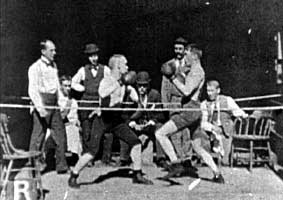 The Hornbacker-Murphy Fight (1894) has been posted on the web under the mistaken title Glenroy Brothers (Comic Boxing) (1894), which is a different film.
The Hornbacker-Murphy Fight (1894) has been posted on the web under the mistaken title Glenroy Brothers (Comic Boxing) (1894), which is a different film.
The mistake first appeared in a Kino compilation The Movies Begin, corrected in a later compilation in which both The Hornback-Murphy Fight & Glenroy Brothers No. 2 (1894) are shown together, but the earlier Glenroy Brothers (Comic Boxing) is as I write this still unavailable.
Looking like kids or bantam-weight boxers, Eugene Hornbacker & his opponent put on quite a phony looking match for less than half a minute.
Initially there were five twenty-second rounds. In order to see an entire fight, customers would have to pay another penny for each round, making what would otherwise be a one-cent customer worth a nickel, just as in the larger Kinetoscope Exhibiting Company machines a six-round fight for a nickel a round turned a five-cent customer into two-bits & a nickel's profit.
Along the back of the ring stand boxing spectators who were Edison employees. The referee seems more likely to have been the real deal, though he does break them up rather too often. Judging by both men's level of skill, it's no wonder that neither were ever famous fighters, & there were so many fighting Murphies at the time that his specific identity is now unknown.
As for the Glenroy Brothers, they had a vaudeville act called "The Comic View of Boxing: The Tramp & the Athlete." A twenty-second sampling of their performance is provided in Glenroy Brothers No 2. They were supposed to convey a boxer with classic training fighting an untrained opponent.
The basis of the act is that one boxer (in a white jumpsuit) is classically trained, while his challenger (in grey) is just a tramp. Because the tramp does a cartwheel & otherwise behaves unpredictably, the classically trained boxer doesn't necessarily have the upper hand.
Billy Edwards & the Unknown; aka, Billy Edwards Boxing (1895) was originally filmed as a five-round boxing match in twenty second episodes, but only one episode survives.
Billy Edwards was the Lightweight Champion of America from 1868 to 1872. But this is 1895. He was by this time a middle-aged boxing instructor & sports writer, no longer a fighter. He had enough of a name to be given a "role" playing himself, & it's the only extant footage of the once-famed fighter in motion.
His opponent is an unknown sometimes identified as "Warwick." He looks enough like Edwards to be a relative, leading to past misidentifications with the Glenroy Brothers.
By this fragment it seems clear that the crew at Black Maria studio took their responsibility to make commercially essential boxing films as a burden, & made small effort with them.
Boxing films would sell well whether or not they paid someone like Corbett a great deal to make it real. For Billy Edwards, though, the film got him invites for boxing exhibitions in New York & Philadelphia, so he was kind of the George Foreman of his day making a late comeback.
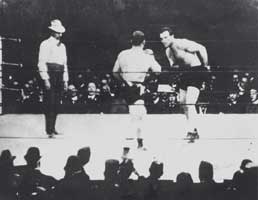 James "the Boilermaker" Jeffries fights Ruby Robert Fitzsimmons in The Fitzsimmons-Jeffries Fight (1899) which took a leap toward realism. James "the Boilermaker" Jeffries fights Ruby Robert Fitzsimmons in The Fitzsimmons-Jeffries Fight (1899) which took a leap toward realism.
It is a totally convincing reenactment of the final round of their fight at the Coney Island Athletic Club, the boxers having been paid by the Edison company to do their best to recreate that last punch that took down Bob Fitzsimmons.
Lubin about the same time released a "reproduction" of the fight, without benefit of either boxer. But the era when boxing fans would pay to see impersonations of famous fights & fighters was about to end.
The Jeffries-Sharkey Contest (1899) captures a wollaping 135 minutes of a fight at the Coney Island Athletic Club said to be the last important fight of the century, & the first indoor fight successfully filmed as it happened.
The totally authentic footage of the great Jim Jeffries & Tom "Sailor" Sharkey opened the floodgates of the public's desire for real fight footage, & Jeffries would star in a lot of it for the following decade, as also Bob Fitzsimmons, Jim Corbett, & others from the end of the Victorian era, besides newly arising talent, notably the splendid Jack Johnson.
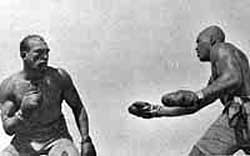 Jack Johnson was the original Mohammed Ali, in truly the first important fight of the new century, immortalized as Jeffries-Johnson World's Championship Boxing Contest, Held at Reno, Nevada, July 4, 1910 (1910).
Jack Johnson was the original Mohammed Ali, in truly the first important fight of the new century, immortalized as Jeffries-Johnson World's Championship Boxing Contest, Held at Reno, Nevada, July 4, 1910 (1910).
Johnson kept his title against "the great white hope" Jim Jeffries. The racism that made this popular fight film so controversal shockingly enough caused Congress to ban interstate "trafficking" in fight films soon after. See the review of Unforgivable Blackness (2004).
The oldest vintage silent films from right around 1900 can be likeable as primitive cinema, a lot of charm goes out of boxing films when they become "real," & they are films for boxing fans who care about the history of boxing & the great fighters of the past.
But at the start of that late-Victorian market for boxing films, the comedy, the fakery & staginess, the well-intended re-enactments, & the struggle to overcome the limitations imposed by stationary cameras, made those early films intriguing for film buffs interested in motion picture art's origins.
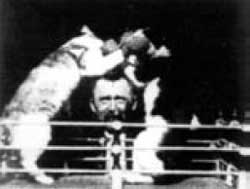 Given the tendency to make jesting films & condensed versions of vaudeville acts, it's no great surprise that the popularity of boxing films was soon parodied.
Given the tendency to make jesting films & condensed versions of vaudeville acts, it's no great surprise that the popularity of boxing films was soon parodied.
A wacky novelty act involving two cats in a miniature boxing ring with boxing gloves on their wee paws comes to us courtesy of Boxing Cats (Professor Welton's) (1894). It's less than a half-minute of cat abuse for silly entertainment's sake.
"Professor" Welton is actually using the cats like puppets, but it's a pretty convincing bit of boxing, very funny, & I don't think the cats look that worried about it.
Welton's complete act included cats who turned somersaults & rode kitty-scale bicycles, but by the evidence of this film, it amounted to puppetry with cats trained only to remain calm while being manipulated by Welton.
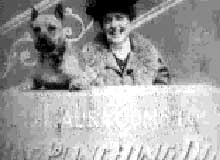 A mite more serious are The Cock Fight (1894) & The Cock Fight No. 2 (1894). The first of this pair of films is less than three-quarters of a minute, remade later the same year in order to switch to a white background to make the action of the roosters clearer. A mite more serious are The Cock Fight (1894) & The Cock Fight No. 2 (1894). The first of this pair of films is less than three-quarters of a minute, remade later the same year in order to switch to a white background to make the action of the roosters clearer.
Frequently mislabeled in reviews, the thing to remember is that it's No. 2 that has the white background. We can see the head & torso of one man, & the head of another man, poking into the pen where the roosters have been deposited in front of the camera.
Laura Comstock's Bag Punching Dog (1901) was named Mannie. The film is only a minute long but what a wacky minute. The vaudeville performer's dog is shown jumping & jumping & jumping at a punching bag, like in David Letterman's Stupid Pet Tricks.
For reward he's permitted to "catch" the punching bag, so the vignette ends with the bag getting the daylights shaken out of it.
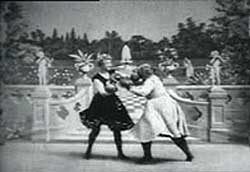 It's no great leap from cats, dogs & chickens to women fighting.
It's no great leap from cats, dogs & chickens to women fighting.
In Gordon Sisters Boxing (1901) we see two women in flouncy dresses, one wearing white (Minnie Gordon), one wearing black (Bessy Gordon). They're on a stage with a genteel backdrop conveying an outdoor garden.
They zip around the stage with boxing gloves punching at each other for two minutes. They're pretty darned good at it & this must've been hot stuff in 1901, when they were popular entertainers on the vaudeville circuit on the eastern seaboard of the United States.
The Gordon sisters framed their performance as a "bag-punching & scientific act" faking educational value for what was fundamentally a burlesque.
copyright © by Paghat the Ratgirl
|
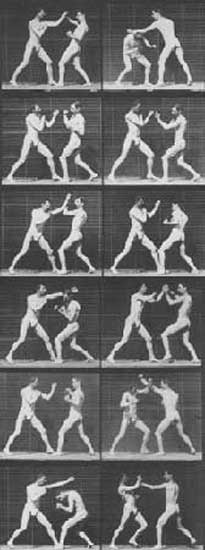

 But even with these provisos, the first boxing match on film would still be the Leonard-Cushing Fight. Footage initially consisted of six rounds, each round on a different piece of film, each round sold separately to be viewed in a kinetoscope.
But even with these provisos, the first boxing match on film would still be the Leonard-Cushing Fight. Footage initially consisted of six rounds, each round on a different piece of film, each round sold separately to be viewed in a kinetoscope.





